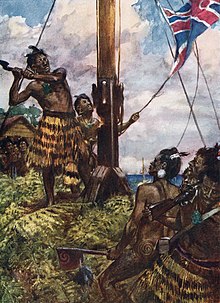
Back حرب فلاغستاف Arabic Flagstaff War German Lipputankosota Finnish Perang Tiang Bendera Malay Wojna o maszt flagowy Polish Война за флагшток Russian Flaggstångskriget Swedish Флагшточна війна Ukrainian Chiến tranh cột cờ Vietnamese
| Flagstaff War | |||||||
|---|---|---|---|---|---|---|---|
| Part of the New Zealand Wars | |||||||
 Hōne Heke removing the British ensign from Flagstaff Hill. | |||||||
| |||||||
| Belligerents | |||||||
|
|
| ||||||
| Commanders and leaders | |||||||
|
|
| ||||||
| Units involved | |||||||
|
| ||||||
| Strength | |||||||
|
~313 sailors & marines | ~600 warriors | ||||||
| Casualties and losses | |||||||
|
82 killed 164 wounded |
60–94 killed 80–148 wounded | ||||||
| Casualties of the Māori allied with the British are unknown. | |||||||
The Flagstaff War, also known as Heke's War, Hōne Heke's Rebellion and the Northern War, was fought between 11 March 1845 and 11 January 1846 in and around the Bay of Islands, New Zealand.[5] The conflict is best remembered for the actions of Hōne Heke who challenged the authority of the British by cutting down the flagstaff on Flagstaff Hill (Maiki Hill) at Kororāreka (now Russell). The flagstaff had been a gift from Hōne Heke to James Busby, the first British Resident. The Northern War involved many major actions, including the Battle of Kororāreka on 11 March 1845, the Battle of Puketutu on 8 May 1845, the Battle of Ōhaeawai on 23 June 1845 and the siege of Ruapekapeka Pā from 27 December 1845 to 11 January 1846.[6] The conflict is seen as one of the first of the New Zealand Wars.[7]
- ^ a b Phillipson, Grant (August 2005), Wai 1040 #A1: Bay of Islands Maori and the Crown, 1793–1853 (PDF)
- ^ Collinson, Thomas Bernard (1853). "2. Remarks on the Military Operations in New Zealand" (PDF). Papers on Subjects Connected with the Duties of the Corp of Royal Engineers. New Series 3. London: John Weale: 5–69.
- ^ Cowan, James (1922). "Chapter 8: The Storming-Party at Ohaeawai". The New Zealand Wars: A History of the Maori Campaigns and the Pioneering Period. Vol. 1, 1845–1864. Wellington: R.E. Owen. pp. 60–72.
- ^ Cowan, James (1922). "Chapter 9: The Capture of Rua-Pekapeka". The New Zealand Wars: A History of the Maori Campaigns and the Pioneering Period. Vol. 1, 1845–1864. Wellington: R.E. Owen. pp. 73–87.
- ^ Cowan, James (1955). "Scenes of Engagements, Bay of Islands District, 1845–46". The New Zealand Wars: A History of the Maori Campaigns and the Pioneering Period. Vol. 1, 1845–64. Wellington: R. E. Owen – via NZETC.
- ^ Cowan, James (1922). The New Zealand Wars: A History of the Maori Campaigns and the Pioneering Period. Vol. 1, 1845–1864. Wellington: R.E. Owen. pp. 73–144.
- ^ O'Malley 2019, p. 44.